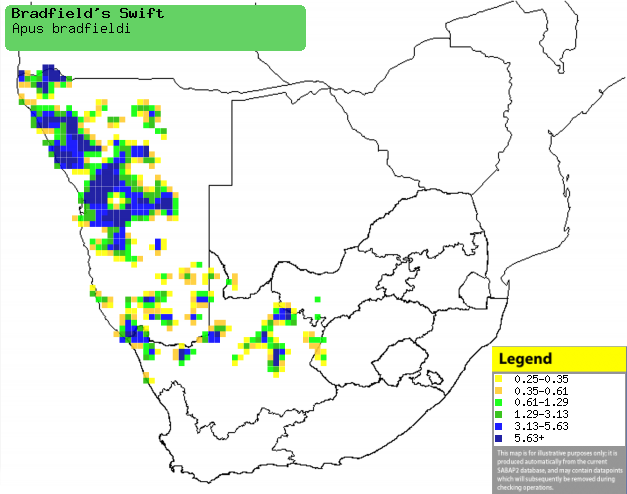|
Apus bradfieldi (Bradfield's
swift)
Muiskleurwindswael [Afrikaans]; Damara-gierzwaluw [Dutch];
Martinet de Bradfield [French]; Damarasegler [German]; Andorinhão de Bradfield
[Portuguese]
Life
> Eukaryotes >
Opisthokonta
> Metazoa (animals) >
Bilateria >
Deuterostomia > Chordata >
Craniata > Vertebrata (vertebrates) > Gnathostomata (jawed
vertebrates) > Teleostomi (teleost fish) > Osteichthyes (bony fish) > Class:
Sarcopterygii (lobe-finned
fish) > Stegocephalia (terrestrial
vertebrates) > Tetrapoda
(four-legged vertebrates) > Reptiliomorpha > Amniota >
Reptilia (reptiles) >
Romeriida > Diapsida > Archosauromorpha > Archosauria >
Dinosauria
(dinosaurs) > Saurischia > Theropoda (bipedal predatory dinosaurs) >
Coelurosauria > Maniraptora > Aves (birds) > Order: Apodiformes >
Family: Apodidae
Near endemic to southern Africa, occurring from south-western
Angola to Namibia and the Northern Cape. It generally prefers arid habitats,
such as desert and open savanna, often rocky, mountainous areas. It forages in
flocks, almost exclusively eating termite alates, bees and other flying insects.
Its breeding habits are little known, however it is thought to be a monogamous
colonial nester. The nest is a makeshift half cup, made of plant material and
feathers glued together with saliva. They are usually grouped in colonies, often
in rock crevices, buildings, mine workings and dead fronds of alien palm trees
(see image above).
|
 |
|
Distribution of Bradfield's swift in southern Africa,
based on statistical smoothing of the records from first SA Bird Atlas
Project (©
Animal Demography unit, University of
Cape Town; smoothing by Birgit Erni and Francesca Little). Colours range
from dark blue (most common) through to yellow (least common).
See here for the latest distribution
from the SABAP2. |
Threats
Not threatened.
References
-
Hockey PAR, Dean WRJ and Ryan PG 2005. Roberts
- Birds of southern Africa, VIIth ed. The Trustees of the John Voelcker
Bird Book Fund, Cape Town.
|
